With Ecuador and its Galapagos Islands province now reaching a vaccination rate that’s above 87{fd1018b708dc11e6d771fa6d5ce8eacdee7a6add7c2315f27e48bc4e47591114}, the country has now re-opened to international travel. Likewise, travelers are once again reminded that vacationing in the Galapagos is like walking into your own NatGeo documentary.
As Darwin himself noted, these islands are home to some of the world’s rarest and most wonderful creatures, therefore a wildlife tour on this fascinating archipelago is not to be missed. So if you are looking for a truly unique wildlife vacation, then Galapagos ticks off all the boxes.
Here, we have highlighted some of the species that you can discover in the islands, an archipelago where visitors are rewarded with unbelievably up-close encounters with the most iconic Galapagos Islands wildlife species.
1. Galapagos greater flamingos
Though not endemic to the Galapagos archipelago, these elegant birds are still a favorite of visitors to the islands. More vividly pink than their European counterparts, this intense color is the result of a diet of brine shrimp, which they catch by dipping their long necks under the brackish saltwater.
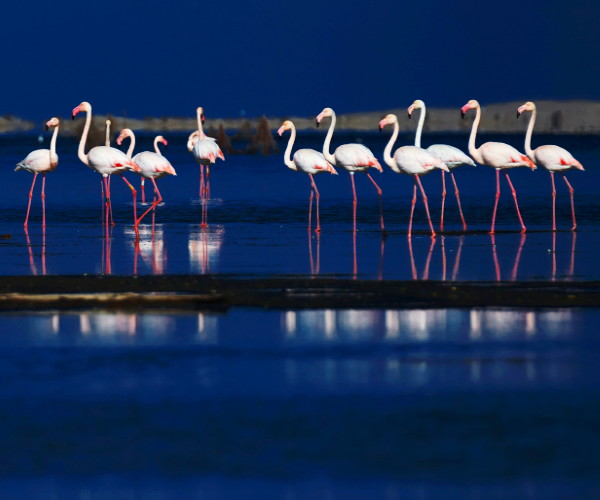
According to a recent census, the population of flamingos in Galapagos numbers only about 400 individuals, with Isabela Island being the species’ most prominent residence. As these beautiful birds are known to fly from lagoon to lagoon —and even from island to island— you may be fortunate enough to spot them in flight with their elongated necks and extra-long legs outstretched to the max – a very special sight on any Galapagos tour.
2. Galapagos hammerhead shark
As the Galapagos Islands is a world-class snorkeling and diving destination, every year thousands of visitors strap on their masks and dive on in to spend quality time with the local marine life. Divers in particular can witness the amazing sight of non-aggressive hammerhead sharks prowling the waters of the far north-west Darwin and Wolf islands. Here you don’t just see one or two lone sharks, but occasionally entire schools of Galapagos hammerhead numbering up to several hundred at a time!
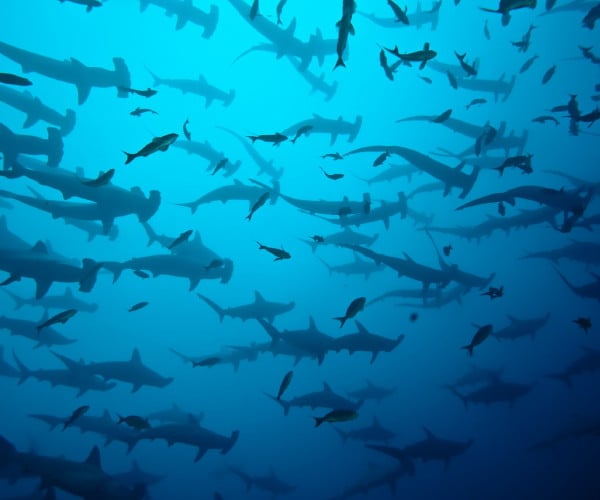
3. Waved albatross
One of the rarest birds in the world, the streamlined Waved Albatross nests in only one place: Española Island in the Galapagos. This is where their numbers swell to over 30,000 between the months of April to December.
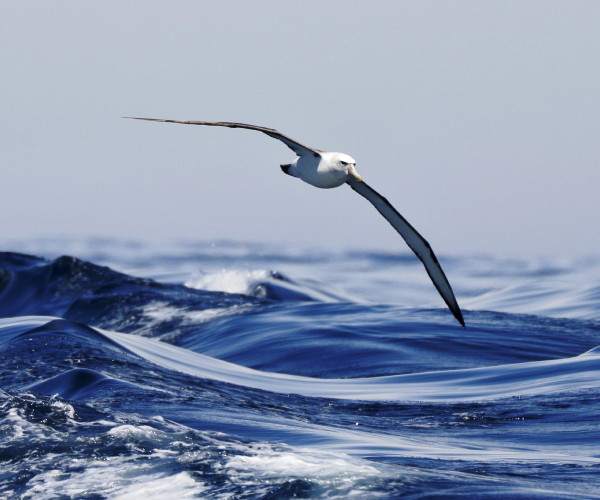
As these large birds boast a massive wingspan that can reach over eight feet (2.5 meters), this assists them in flying out at sea for days at a time, where they scour the waters for squid and fish. Seeing a waved albatross in flight is quite the sight, as they glide gracefully while up in the skies. Landing and take-off for these large birds, however, are different matters, as both of these movements somewhat clumsy … if not comical. Similarly, the bird’s walking is an ungainly waddle.
On the brighter side, the Galapagos albatross engages in a rather elaborate courtship dance that the fortunate traveler is honored to see. The romantic ballet involves a good deal of bill circling, clacking, head nodding, and waddling, as well as a strange sound not unlike a cow’s moo. But once an albatross has selected a partner, they mate for life. Perhaps this adds to why age-old ancient legends attribute the albatross as “representing the innocence and beauty of God’s creation.”
4. Whale Sharks
As the Galapagos Islands are an important stopping-off point on the migratory path of whale sharks, this makes the archipelago one of the most reliable places on the planet for whale shark watching. The Galapagos Islands are recognized as one of the few spots where you can consistently dive with these titan creatures, and perhaps the only place to dive with large adult specimens measuring 30-36 feet (10-12 m) in length. Despite their intimidating size, though, these are extremely gentle creatures of the deep and have never harmed a human – so you’ll be quite safe in the water with them.
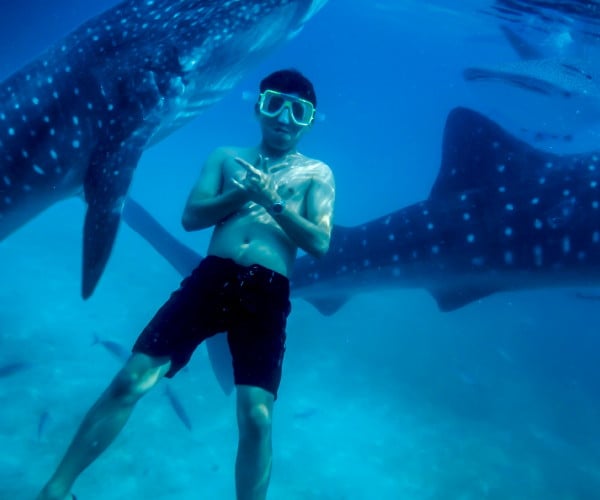
5. Galapagos marine iguanas
With their wide-set eyes, smashed-in faces, spiky scales, and knotty, salt-encrusted heads, the much-maligned marine iguana is not the prettiest creature in the Galapagos Islands (even Charles Darwin piled on, describing them as “hideous-looking” and “most disgusting, clumsy lizards”). But what these horrid creatures lack in looks they make up for with their amazing and unique ecological adaptations.
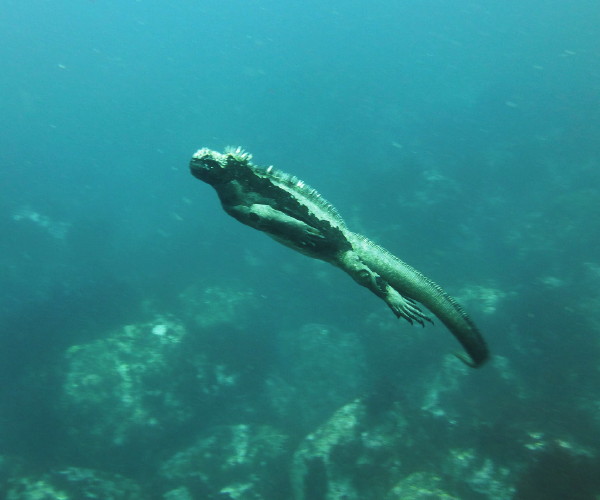
Endemic to the Galapagos Islands, marine iguanas are the only lizard in the world with the ability to live and forage underwater. They enter the sea to feed on algae, and are extremely agile in the water, using their powerful tails as rudders. When on land, they often huddle together in large groups to generate warmth under the sun. After swimming, their bodies discharge sea salt by sneezing it out of their nose via specialized glands. This amazing reptile can be found across the entire archipelago, with particularly large colonies on Fernandina, Isabela and Española Islands.
6. Galapagos land iguanas
Measuring up to three feet in length and weighing up to 30 pounds, Galapagos land iguanas are miniature Godzillas frequently seen lumbering through dry scrubland practically everywhere throughout the archipelago. It’s commonly believed that the first land iguanas reached the Galapagos from the mainland several million years ago by clinging onto clumps of vegetation or driftwood. With greater endurance and less need for fresh water, they were more likely than mammals to survive the journey. Today, they inhabit arid zones usually close to forests of cactus, which is their principal food source. Thanks to the thick skin within their mouths, they eat the cactus pads, spines and all!
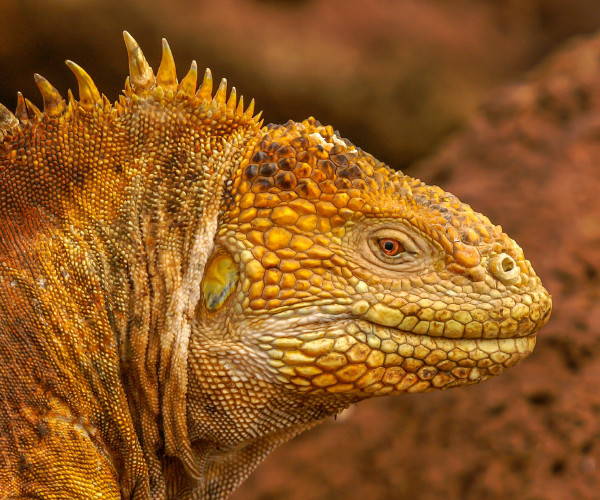
As you trek along scenic paths through the islands, you’ll almost certainly run into these iguanas, which are solitary creatures – unlike Marine iguanas who prefer to group together into large colonies. Also unlike their aquatic cousins, these little fellas have a kind of prehistoric-looking charm about them that makes them extremely photogenic.
7. Frigate birds
As they soar across the azure Galapagos sky like a prehistoric Pterodactyl, the sighting of a Galapagos Frigate bird is guaranteed during any Galapagos cruise or land trip. These large black sea birds with forked tails and long curved beaks are noted for the male’s large red throat pouch, which is dramatically inflated like a balloon during mating season. As he then spreads his wings and points his head to the sky while clattering his bill, a female will circle overhead, carefully assessing her options. After taking her time, she’ll look for something that she likes – perhaps a particularly good-looking male or a well-made nest – and then fly down to join her selected soulmate.
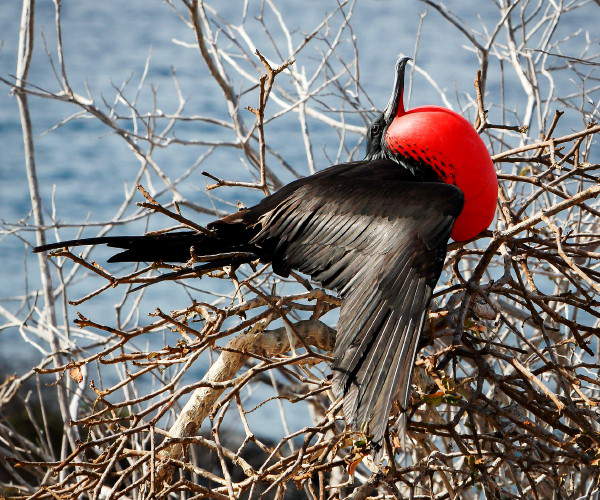
On the less romantic side, these birds are also known as the “pirates of the sea,” as they take advantage of their large size to snatch food from other smaller birds such as Blue-footed boobies.
8. Rays
Graceful rays can be seen gliding through the waters around the Galapagos Islands, where they are commonly seen during snorkeling activities, though they can sometimes be sighted from a cruise yacht as well. Those people who have dived alongside any of the rays of the archipelago — witnessing their gentle, elegant and avian-like motions — describe this creature’s actions as the closest thing to flying.
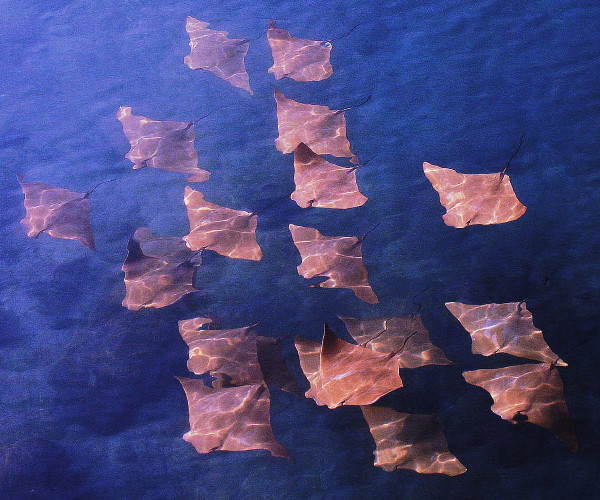
Of the four different sorts of rays that you may see in the Galapagos, stingrays are the most commonly sighted, as they can be found anywhere there’s a sandy bottom with occasional rocks. Despite their reputation, they are not aggressive and will not “attack” snorkelers. You’re only in danger from it if you step on one.
Dazzling Golden Cownose Rays often travel in groups but aren’t very large, reaching up to about a meter across, while Spotted Eagle rays are much larger, some reaching two meters across. Manta rays, however, are enormous beasts with wingspans of up to 12 feet (3m). If you see one, you’ll know it, as they are massive and impossible to mistake for anything else. In many dive sites in the Galapagos Islands, the search for Giant manta rays can be an effort – often an unsuccessful one. But at Isabela Island’s Cape Marshall, the sighting of this astonishing species is almost guaranteed.
9. Darwin’s finches
Galapagos finches are unremarkable at first blush; they’re small birds with small pointy beaks that flit around in low shrubs and on the ground – that’s it. It’s their evolutionary path, however, that makes them so interesting, as Charles Darwin discovered during his second voyage of the Beagle. He noted that 13 distinct sub-species of finches had all descended from a common ancestor that had somehow found its way to the islands eons ago. As these sub-species were different from island to island, he concluded that each had evolved in its own way to perfectly fit with the environment on their respective island. The great nineteenth-century naturalist then used this fact to illustrate his Theory of Evolution, which today explains the process of life itself.
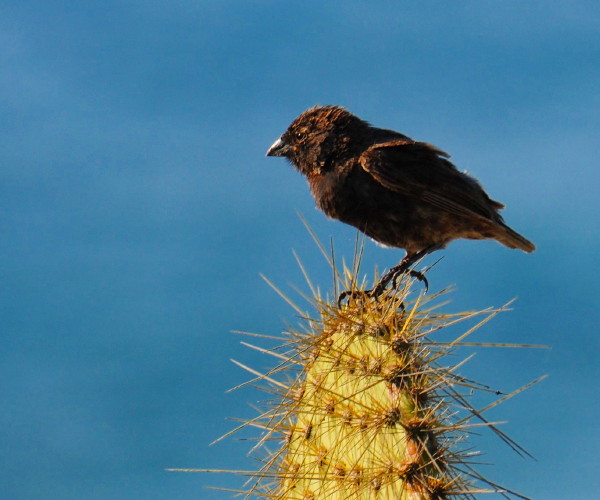
10. Bottlenose dolphins
Some dolphin species prefer to live in the Galapagos and remain around the archipelago for years, making the islands their permanent home, while others pass through the archipelago along migration routes. The variety most often seen by visitors, though, is the Bottlenose Dolphin. In any case, the sighting of dolphins of any variety is thrilling. Groups of them will escort cruise yachts, where they enjoy putting on a good show as they ride the bow waves, leaping and flipping alongside the ships. The best time to spot dolphins in the gorgeous Galapagos Islands is between June and October, particularly on a cruise between the Isabela and Fernandina islands.
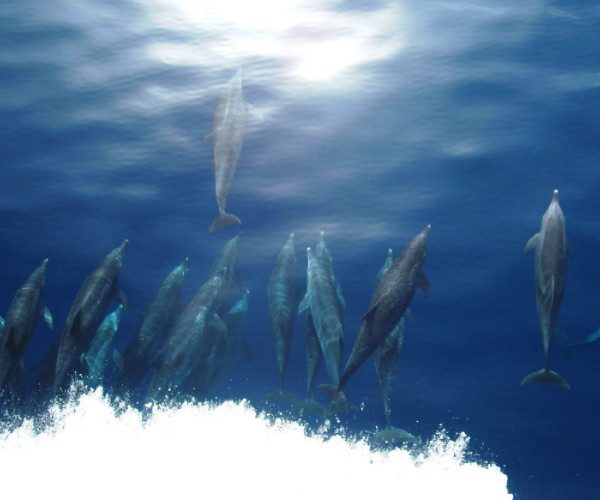
11. Blue-footed boobies
Common and cute, Blue-footed boobies are one of the most iconic creatures of the Galapagos Islands. They can easily be recognized by their blue feet, after which they are named. Found everywhere in the islands, they’re not hard to spot, and if you’re lucky, you might even get a chance to witness their fascinating courtship dance. This can be observed in their breeding season, when you can see lots of hooting, honking and pointing beaks skyward. This takes place at different times on different islands, but around March is a good time to see it. Chicks hatch in June or so and need five to six months before they can fly.
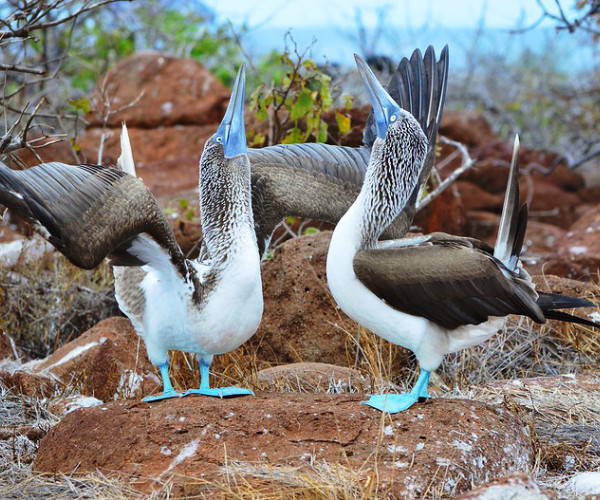
(Also inhabiting the islands are Red-footed boobies, which — unsurprisingly — are characterized by their bright red feet, and Nazca boobies, also known as the “masked booby” for the black mask-like features on their face.)
12. Sally Lightfoot crabs
Scurrying around rock pools or hiding in the cervices of black lava, the brilliantly colored Sally-Lightfoot Crab is present on all Galapagos islands. With their bright red bodies, light blue undercarriages, orange faces, and beady pink eyes, these coastal scavengers possess the agility to jump from rock to rock, run in four directions, climb up vertical slopes, and are even capable of quickly skipping over water, hence the name “light foot.”

Remarkably, you’ll often spot Sally Light Foots in a unique symbiotic relationship with Marine Iguanas. The Sally Light Foot will eat bugs off an iguana’s body, giving the crab a tasty meal while relieving the reptile of parasites.
13. Galapagos penguins
The Galapagos archipelago is home to the only species of penguin found north of the Equator and the second-smallest penguin species in the world – and they couldn’t be cuter. Fortunate snorkelers will get to see how these tiny birds are amazingly quick underwater, as they dart around, nipping up small fish! You can get to see them in many places, including on Isabela Island, Fernandina Island, Santa Cruz Island, as well as Bartolome, Santiago and Floreana islands. Most nests are seen between May and January.
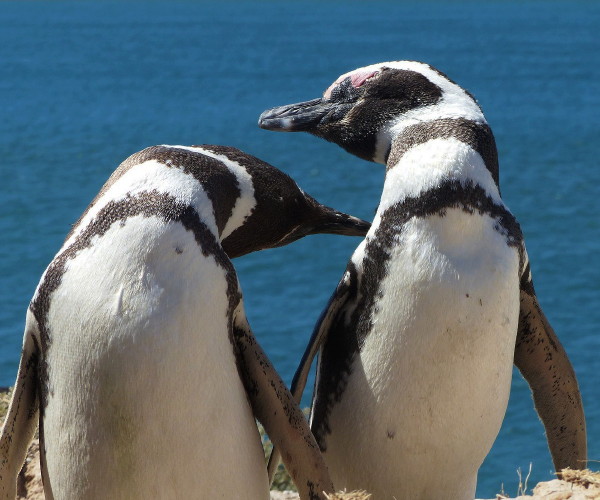
14. Green Sea Turtles
The most common species of sea turtle family in the Galapagos archipelago is the Galapagos green turtle. They are often sighted by snorkelers, as these gentle green giants often feed in fairly shallow waters, gnawing at seaweed and feeding on algae covering the rocks.
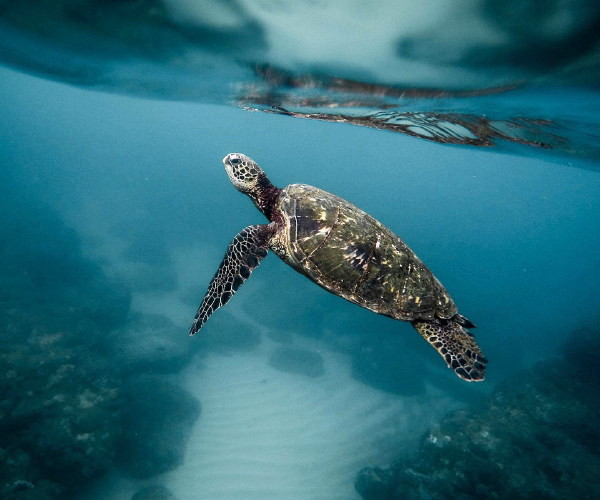
Though they’re not as large as the famous Galapagos Giant tortoises (described below), these turtles can get quite hefty, reaching an average adult weight of 440 pounds.
However, reaching adulthood is a true feat in itself, keeping in mind that typically only 1 in 1000 turtles survive to that age. After breaking out of their eggs, new turtle hatchlings must first negotiate their way to the sea beneath the eyes of hungry Frigate birds and hawks, and even those hatchlings that reach the ocean have more trials ahead of them, as sharks and other marine species are constantly on the prowl for food. With this in mind, you’ll understand why signs are posted on certain beaches to keep visitors from disturbing turtle nests. Sea turtles can be found on most islands in the archipelago, where the prime season for nesting is from December to June.
IMPORTANT NOTICE:
If you are reading this article anywhere other than on A Luxury Travel Blog, then the chances are that this content has been stolen without permission.
Please make a note of the web address above and contact A Luxury Travel Blog to advise them of this issue.
Thank you for your help in combatting content theft.
15. Flightless cormorants
The Flightless Cormorant’s story is interesting in that its short, stunted wings are the consequence of its evolution in the isolated habitat of the Galapagos islands. One theory suggests that because the bird had so few land predators, it didn’t need to fly. Having no enemies, taking its food primarily through swimming and diving along the food-rich shorelines, and not needing to travel to breeding grounds, the bird has eventually become the only known cormorant that has lost the ability to fly. Indeed, wings whose feathers would trap air are likely to have been a disadvantage to the cormorants, which dive from the surface.
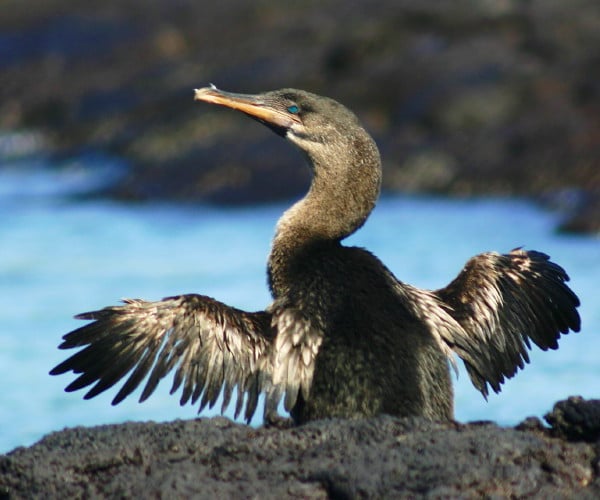
The Flightless Cormorant bird is endemic to Galapagos, so you can only find them here. It’s also interesting that because the bird has no natural land enemies, they have no fear of humans and can easily be approached.
With only 1,500 estimated individuals, it’s also one of the world’s rarest birds and is the subject of an active conservation program. So why not plan a vacation to see them? They’re found along the east coast of Fernandina Island, as well as on the northern and western coasts of Isabela Island, where their nesting tends to take place from July to October.
16. Sea lions
The Galapagos sea lion is the most ubiquitous mammal in the islands. They’re found pretty much everywhere, from snoozing on a beach or swimming near the islands. While in town, you’re even advised to check under any bench before you sit down, as these are favorite sea lion hang-outs. If you are very lucky, curious young sea lions may play with you while you snorkel.
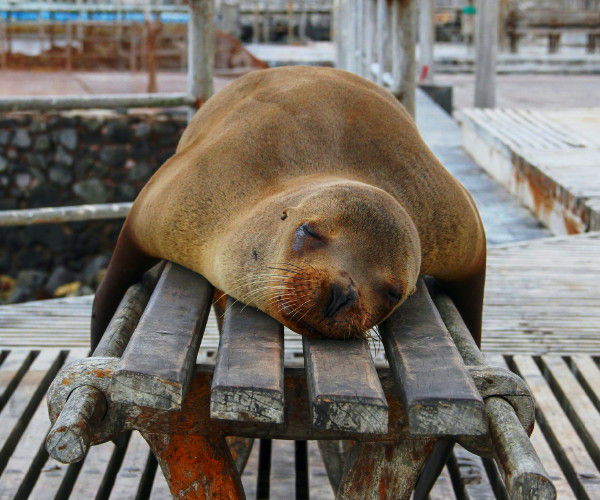
You can find particularly large colonies at Gardner Bay (Española Island), Isla Lobos (San Cristobal Island), and the Harbor Area of Isabela Island. If you’re in the central town of Puerto Ayora (Santa Cruz Island), head over to the fisherman’s dock to catch a glimpse of the sea lions, which have been unofficially adopted by fishermen who feed them scraps.
17. Galapagos hawks
Until the arrival of humans (along with their cats, dogs and other domesticated animals), the Galapagos hawk enjoyed the status of the archipelago’s top predator animal. Tough, swift and strong, this endemic hawk feeds mainly on rats, mice, reptiles and smaller birds, but is capable of taking on a medium-sized iguana or small Galapagos tortoises if they’re hungry enough. They’re found on every island.
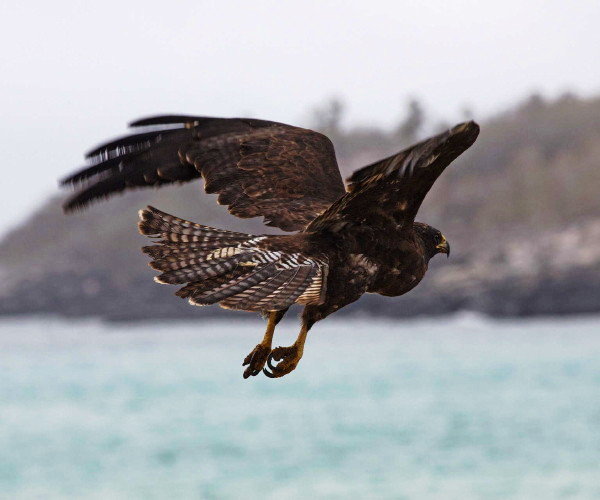
18. Humpback whales
The greatest thrills of a Galapagos vacation are often the unexpected encounters, and few are more exhilarating than catching a glimpse of a breaching Galapagos whale. Over 20 different species of whales have been recorded off the waters of the archipelago, where possible sightings include gigantic Blue whales, Sperm whales, Humpbacks, and the smaller Bryde’s whales and Orcas.
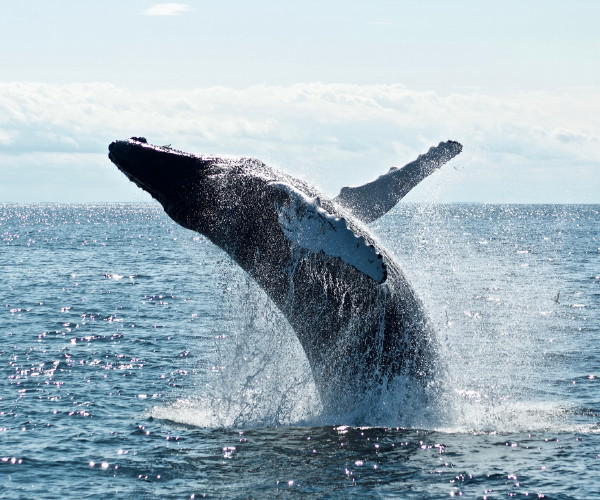
One of the most commonly seen whales in the archipelago is the Humpback, easily recognizable as the one that launches itself out of the water and then slams back down into the sea.
These can be seen mainly during the cooler months from July to December. So during Galapagos whale watching season, keep your camera handy, your eyes peeled, and stay out on deck. If you’re lucky — and quick — you might just capture a moment of rare beauty.
19. Galapagos brown pelicans
One bird you’ll see several times during your Galapagos vacation is the stately Brown Pelican, the smallest of all pelican species. This bird is widespread throughout the archipelago but can also be seen as far away as the mainland’s coast.
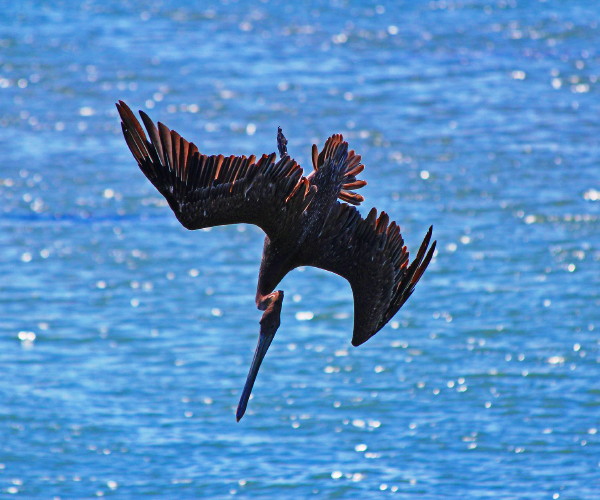
The Brown Pelican can be seen flying gracefully very close to the water’s surface, where they use an aerodynamic principle called the “ground effect.” Through this, the air trapped between their wings and the water increases their gliding efficiency, therefore saving them energy. Once spotting prey, they will then plunge-dive into the sea for food, a technique that allows them to catch a beak full of fish but also water. They then filter the water out and feast on the small fish and crustaceans that remain before they head back to their nests in the mangrove lagoons.
20. Galapagos giant tortoises
Probably the most iconic animal in the archipelago, Galapagos giant tortoises tend to be one of the main reasons why people travel to the Galapagos Islands. They can usually be found lumbering along highland trails or wallowing in mud pools.

As Darwin noted, the Giant Tortoise is a wonderful example of evolution in action. They are thought to be descended from a mainland species of tortoise that drifted to Galapagos shores on ocean currents some 2-3 million years ago. There are now 15 subspecies endemic to different islands, with each subspecies having evolved and now differentiated by size, habitat and shell types (dome-shaped or saddle-back).
Though different, they have all evolved into giants, weighing up to 900 pounds thanks to the islands’ abundant food sources and the lack of predators. These idyllic conditions have also allowed many of the tortoises to live to a ripe old age of up to 120 years.
To view them in their natural habitat, the highlands of Santa Cruz Island or Isabela Island are your best bet, or you can visit any of the several tortoise breeding centers that raise hatchlings for release back into the wild, the most noted of which being the Charles Darwin Research Center on Santa Cruz Island.
Alfonso Tandazo is President and CEO at Surtrek Tour Operator. Surtrek Tour Operator is a well-established firm, specializing in custom-designed luxury tours in Ecuador, the Galapagos and throughout the rest of South America.
If you would like to be a guest blogger on A Luxury Travel Blog in order to raise your profile, please contact us.




